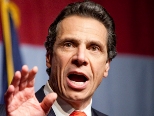 By Stepahanie A. Miner
By Stepahanie A. Miner
The specter of financial collapse looms over New York State’s cities. For some the collapse is imminent, for others a few years off. Instead of confronting these realities, Gov.Andrew M. Cuomo’s proposed state budget avoids them.
The plan, put forward last month, would not increase state aid to cities or do much to reform tax, pension or labor laws. Instead, it would let municipalities push payment of today’s ballooning pension costs into the future, in what amounts to an accounting gimmick.
The stress on cities like Syracuse, where I am mayor, results from profound economic changes but also past decisions by an array of leaders. Mr. Cuomo – whom I consider an ally, despite some differences of opinion – ought to use his substantial, hard-earned political capital to convene the Legislature, the state comptroller, and union and business leaders for an honest conversation about the multiple fiscal pressures confronting our cities.
First, our labor costs are too high – less because of salaries, more because of the rising costs of pensions and health care. City leaders and labor unions jointly negotiated these past arrangements but haven’t cooperated to keep them in check. Most public-sector unions in the state cannot legally strike – instead, unresolved labor disputes go to binding arbitration, which often leads to decisions that cities cannot afford.
Second, revenue in cities like mine has plummeted, and not just because of the Great Recession. Municipal aid and school aid have been cut or have stagnated in recent years. Billions of dollars’ worth of corporate tax breaks have been given away in the name of “economic development.” The state has offered, and the cities have accepted, fiscal gimmicks like borrowing money or using one-time revenue to pay for operating expenses.
Third, the model of using property taxes to finance schools, police, fire, sanitation and other services is no longer sustainable. (New York City, which has relatively low property taxes but levies a city income tax, is an exception.) For decades, once-large industrial employers like Eastman Kodak in Rochester, the Otis Elevator Company in Yonkers and the Carrier Corporation (a maker of heating and air-conditioning equipment) in Syracuse have shed jobs and closed plants. Even when unemployment – 8.2 percent in New York State in December, compared with 7.8 percent nationally – falls, property tax revenue won’t come back.
Finally, demographics have changed. Cities are magnets for immigrants and the poor who need and demand costly social services. The vibrant middle class that once defined urban life moved to the suburbs or exurbs long ago and, with the notable exception of New York City, an influx of well-educated young professionals has not made up for that exodus.
When Mr. Cuomo took office, the state faced a budget crisis. He made some difficult but wise choices, but he has left cities strapped. We are largely restricted from how much we can raise property taxes, even while state aid levels are stagnant. The state is benefiting from a resilient income-tax base, while cities are stuck with an eroded property-tax base.
Mr. Cuomo’s budget proposal would let municipalities and school districts address rising pension costs by borrowing more now – which will mean paying more later on, as interest rates, now at historic lows, are sure to rise. Pension payments have skyrocketed since the stock market plunged in 2007-8; though the market has rebounded, the financial projections underlying pension calculations have changed and the wave of boomer retirees is continuing to drive up costs. Borrowing makes sense when you’re building schools or roads; using it to pay for recurring costs like retiree benefits is a path to insolvency.
In fact, it was such fiscal recklessness that plunged New York City into a fiscal crisis in the mid-1970s.
The Legislature and the state comptroller, Thomas P. DiNapoli, should reject the proposed budget and begin a search for lasting solutions. The worst-case alternatives could be control boards or bankruptcy. Control boards, like the one appointed to oversee New York City’s finances in the mid-1970s, take power from elected officials, are at odds with democratic accountability and often let banks and creditors off the hook with unfairly favorable terms. A chaotic municipal bankruptcy would be even worse, as the recent bankruptcies of Jefferson County, Ala., San Bernardino and Stockton, Calif., and Central Falls, R.I., have shown.
We mayors have proposals on labor arbitration, pension rules, budget gimmicks and taxes. What we don’t have, yet, is the leadership to arrive at a consensus on what will work. For that we need the governor.
Stephanie A. Miner is the mayor of Syracuse and a co-chairwoman of the New York State Democratic Committee.
{Matzav.com Newscenter}











